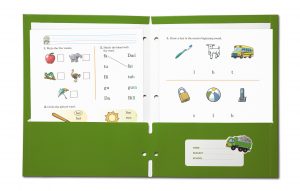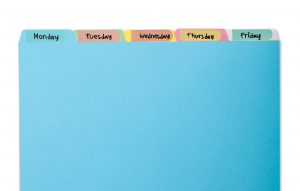Supporting our teachers is what these talks are all about! And one of the biggest challenges you have to overcome as a teacher is paperwork. Though it may start as a light workload at first, paperwork can become overwhelming if you don’t stay on top of it. In this episode of Teacher Talk, we cover all of the ways you can create a working system and try to help you categorize your pesky paperwork.
First, when dealing with a large stack of paperwork, try to think about it in four categories: parents, students, administration/co-workers, and digital. This will help you keep track of importance and responsibilities and offer a manageable system.
Dealing with the Paperwork from Parents
Parental paperwork is one of the big categories. This can begin to get overwhelming because parents send in a lot of notes. Quick examples of this are absent notes or transportation changes: changing from car to bus or the other way around. A simple way to organize these notes is a handy-dandy accordion file. It’s simple and reliable and you can find them anywhere.
The accordion file method:
There are two ways to set up your accordion file. The first is month-by-month. So, nine tabs, one for each month. In the second method, some teachers give each student their own tab. The tab can have the student’s name or they can be assigned a number. Within each month, you can group notes together through paper clips. These can be nurse slips, transportation changes, field trip notes, etc. You can even take this a step further and categorize the notes from the oldest to the most recent.
The main takeaway for the accordion method:
Here you will be able to access a specific note for each child quickly. Instead of shuffling through weeks, or even months, of paperwork, you can have a system that allows you to find the child’s section, the type of note, and even the date you received it.
Digital Communication
Let’s not forget about emails and text messages! Keeping these digital notes organized is equally as important as actual paperwork. Because of the pandemic, most paperwork is going digital and people are communicating more through email. Within your personal email, you can create new folders on the sides. The easiest way to create a system is to give each student their own folder. And anytime a parent sends you an email, put it in their child’s folder. This might take a bit of time to set up for past emails, but it’s worth it.
Paperwork from Administrators and Co-Workers
A lot of times, this specific type of communication can be time-sensitive. And depending on the people and week, sometimes you might have more digital than paper communication. This method is a great way to combat both. For the paperwork, depending on the date, the memo can go into one of two folders. One folder says “urgent,” while the other is labeled “tomorrow.” This helps serve as a visual reminder and reminds you of what needs to be addressed by the end of the day.
What do you do for digital memos? Going back to the idea of creating a specific folder for each child, you can do the same for co-workers. Anytime an administrator sends an email, direct it to their specific folder. It doesn’t mark the emails as read, so the notification for each email is still there as a reminder. You can even label the emails as urgent if necessary. And don’t forget about a planner! A planner is still an extremely helpful tool that serves as a physical and visual reminder.
Student Paperwork
We’ve covered paperwork from parents, administrators, and co-workers, but there is a good bit of paperwork we receive for the students. Let’s start with a simple folder. Each student has their own folder. One side of the folder has stickers and the other side does not. The sticker side is for papers that need to stay at school. And the side without stickers allows kids to take home these papers to the parents. You’ll have to help your students along the process for a few weeks, but eventually, it will become second nature and they’ll understand which papers will stay and which ones will go home.
Student Paperwork for the Teacher
You know what to do with the students’ papers, but what about your own? Someone needs to organize all the tests, workbook pages, and more. Here’s a quick idea! Go out and purchase a packet of about five folders and put food-prep labels on each folder. Each folder represents the day of the week. Use these folders to plan ahead for the current week and upcoming weeks.
Don’t Forget About Homework
We know we keep mentioning folders, but a homework folder is a must! A lot of times, sorting through homework gets a little confusing, and it can be unclear on what needs to be sent back. Parents can use the same sticker and folder system as the kids. One side of the folder has a sticker on it; this side is for papers that need to be signed and then brought back to school. The non-sticker side has papers that parents could keep at home.
Upper Elementary Paperwork
If your students are in upper elementary school, you know there is not quite as much paperwork to keep up with, but you still need to keep tabs on some homework. Here’s what you can do! Have a box or something that you can put the student’s checked homework in. Keep this box hidden away; you never want the student to see you throw the paperwork away. If a student gets the impression that you think of homework as trash, they will have the same feelings.
What About Quizzes and Tests?
Quizzes can be handled the same way as homework. Put them in a folder or box; maybe keep them a little longer than homework, but then you can throw them away. Tests, on the other hand, need to be kept longer. Create a specific folder for tests, for each child, and then place all tests inside, no matter the subject. That way, you can show those quizzes and tests in a parent-teacher meeting.
Dealing with Digital Tests
Let’s circle back and talk about grading tests when your students are remote learning. Number-one item, a USB drive! Ask parents to take a picture of their student’s test with their phone (there are scanner apps available) and email the scanned image to you. Each test can be uploaded onto the USB drive and sorted by the child’s name and the subject of the test. Then the test is placed in the child’s file. Within each file, there are additional files for each subject. This helps you keep track of who turned in a test and who did not. It’s as easy as taking and saving a picture!
We’ve covered a lot, and it can seem overwhelming about where to even start with an organizational process. But keep in mind, it all takes a lot of trial and error. What works for others may or may not work for you and your students specifically. But we hope this episode at least pointed you in a good direction. The most important thing to remember is that organizing paperwork on your end keeps communication open and easily accessible – especially between the students and their parents.






Comments for Taking the “Work” Out of Paperwork
Add A Comment
Your email address will not be published. Required fields are marked *